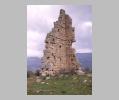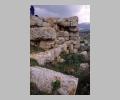| Context: | Oinoe |
| Type: | Fortification |
| Summary: | Rectangular fortification at the eastern end of the Mazi plain in Northern Attica. |
| Date: | ca. 450 BC - ca. 300 BC |
| Dimensions: | Fortification: 110 m (east-west) and at least 150 m (north-south); towers: ca. 9 m square. |
| Region: | Attica |
| Period: | Late Clas./Hell. |
Plan:
Fortified wall with projecting towers. Towers on 4 corners, 1 tower between corners on the east and west walls, 2 towers along the north wall.
History:
Only the north wall is well preserved. The southern boundary is uncertain. Also known as the Myoupolis fort. The pottery, masonry and the location of the site correspond to the known history of the fortified deme of Oinoe. Oinoe is known to have been walled before 431 B.C. and served as an important outpost for the Athenians until the latter phases of the Peloponnesian War. It apparently controlled the roads from Boeotia through the Mazi plain, between Eleusis and Athens. The limestone construction of the west wall could date ca. 420-380 B.C. The conglomerate construction is no earlier than the 2nd half of the 4th century B.C. Black-glazed pottery found inside the wall dates from the 2nd half of the 5th century B.C. through the Hellenistic period.
Other Bibliography:





